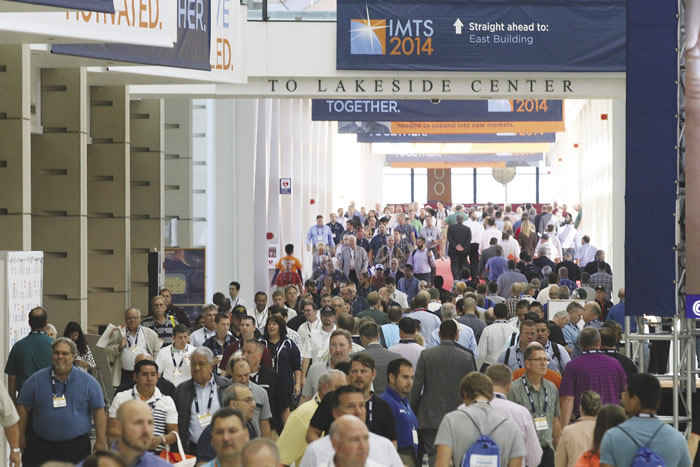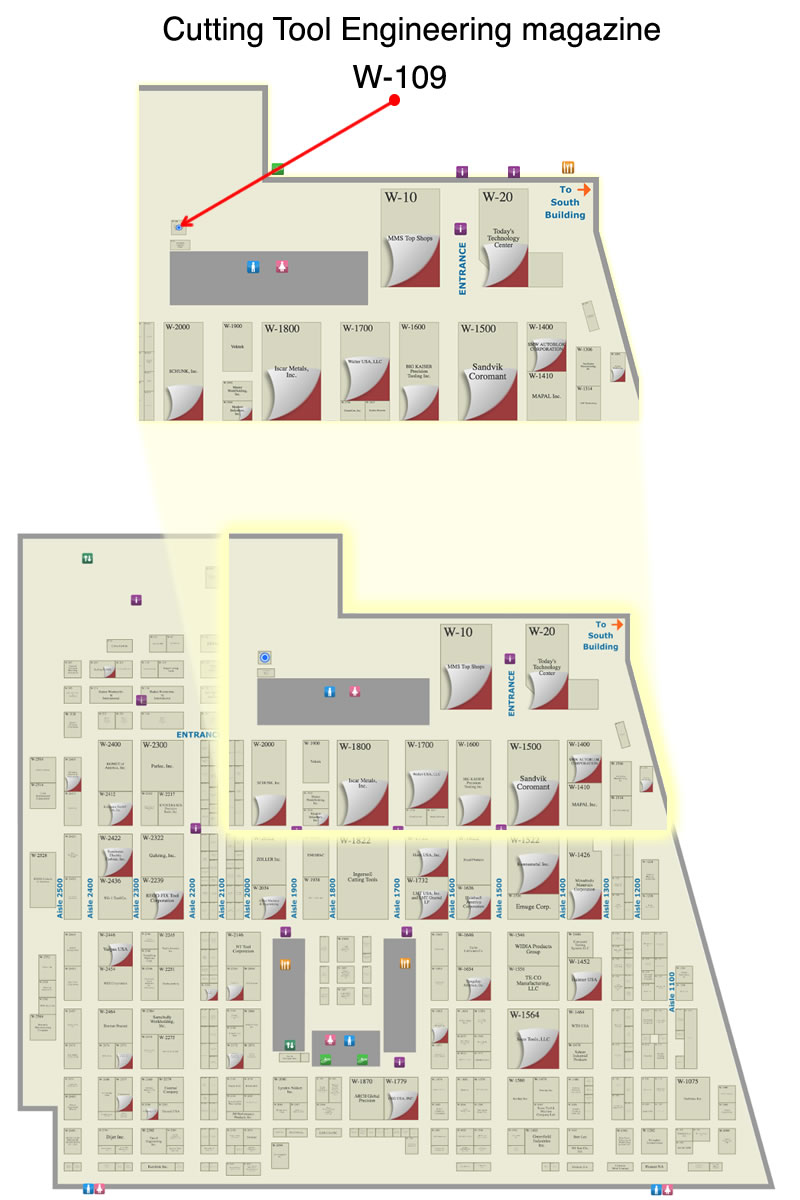 More than 2,000 companies will be exhibiting manufacturing solutions at IMTS 2016.
More than 2,000 companies will be exhibiting manufacturing solutions at IMTS 2016.
This year marks the 31st edition of the International Manufacturing Technology Show. AMT – The Association For Manufacturing Technology, which sponsors the biennial trade show, expects more than 120,000 buyers and sellers of manufacturing equipment and services from at least 112 countries to participate in IMTS 2016. The event takes place Sept. 12–17 at Chicago’s McCormick Place, where more than 2,000 exhibitors will occupy 1.3 million sq. ft. of exhibit space.
Exhibits in the East and West buildings are open from 9 a.m. to 5 p.m., and those in the North, C Hall and South buildings are open from 10 a.m. to 6 p.m.

Plan on sightseeing while in Chicago? Check out Chicago At-A-Glance.

IMTS 2016 is co-located with five other shows: Industrial Automation North America; Motion, Drive & Automation North America; Surface Technology North America; ComVac North America; and Industrial Supply North America—all of which are organized by Hannover Fairs USA.
Cutting Tool Engineering provides coverage of more than 210 of the products that exhibitors will showcase at IMTS 2016. They are divided into tooling and workholding products, machine tools and accessories, and metalworking products. Click the respective links to visit the product preview pages.
IMTS 2016 also includes nine conferences. Along with the eponymous IMTS Conference, which focuses on networking and problem-solving, are the TRAM (TRends in Advanced Machining, manufacturing and materials) Aerospace Conference, the Additive Manufacturing Conference, the Integrated Industries Conference, EOS North America User Day, the Global Automation & Manufacturing Summit, Industrial Laser Conference, Fluid Power Conference and the OPC Foundation Conference.
While at the show, be sure to visit CTE at booth 109 in the West Hall.
IMTS Pavilions
To help guide visitors, IMTS 2016 is organized into 10 pavilions geared toward specific industries, technologies and solutions.

Abrasive Machining/Sawing/Finishing features technology for tight-tolerance and precision surface finish applications, including grinding, sawing and cutoff machines, and various finishing technologies.

Additive Manufacturing shows materials and processes that enable layer-by-layer fabrication of 3D products.

Controls & CAD-CAM focuses on automation and software that can optimize plant operations and provide cost efficiencies.

EDM focuses on CNC wire and sinker EDMs, which are typically used in making tool and die and specialty components.

Fabricating and Lasers targets fabrication, waterjet machining and laser machining. Welding, metal treating and marking equipment are also included.

Gear Generation focuses on gear cutting, forming and finishing, as well as broaching, shaping and slotting.

Machine Components/Cleaning/Environmental focuses on the parts required to monitor and service machines in a safe and environmentally responsible manner.

Metal Cutting focuses on innovations in metalcutting equipment, including machining centers, turning centers and other machine tools.

Quality Assurance features metrology systems and equipment that checks machine accuracy.

Tooling & Workholding focuses on cutting tools and workholding solutions that help shops reduce setup and machining time.
The map below displays the location of the IMTS Pavilions.

The Abrasive Machining/Sawing/Finishing, Additive Manufacturing, Fabricating & Lasers, and Gear Generation pavilions are all in the North Building, B Hall.
The Machine Components/Cleaning/Environmental Pavilion is in the North Building, C Hall.
The Controls & CAD-CAM, EDM, and Quality Assurance pavilions are located in the East Building.
The Metal Cutting Pavilion resides in the South Building.
And the Tooling & Workholding Pavilion is in the West Building.
In addition, the five co-located trade shows are in the East Building.
The Emerging Technology Center and Smartforce Student Summit are in the North Building.
All nine conferences—IMTS Conference, TRAM Aerospace, Additive Manufacturing, Integrated Industries, EOS North America, Global Automation & Manufacturing, Industrial Laser, Fluid Power, and OPC Foundation—are in the West Building.

Related Glossary Terms
- abrasive
abrasive
Substance used for grinding, honing, lapping, superfinishing and polishing. Examples include garnet, emery, corundum, silicon carbide, cubic boron nitride and diamond in various grit sizes.
- broaching
broaching
Operation in which a cutter progressively enlarges a slot or hole or shapes a workpiece exterior. Low teeth start the cut, intermediate teeth remove the majority of the material and high teeth finish the task. Broaching can be a one-step operation, as opposed to milling and slotting, which require repeated passes. Typically, however, broaching also involves multiple passes.
- centers
centers
Cone-shaped pins that support a workpiece by one or two ends during machining. The centers fit into holes drilled in the workpiece ends. Centers that turn with the workpiece are called “live” centers; those that do not are called “dead” centers.
- computer numerical control ( CNC)
computer numerical control ( CNC)
Microprocessor-based controller dedicated to a machine tool that permits the creation or modification of parts. Programmed numerical control activates the machine’s servos and spindle drives and controls the various machining operations. See DNC, direct numerical control; NC, numerical control.
- cutoff
cutoff
Step that prepares a slug, blank or other workpiece for machining or other processing by separating it from the original stock. Performed on lathes, chucking machines, automatic screw machines and other turning machines. Also performed on milling machines, machining centers with slitting saws and sawing machines with cold (circular) saws, hacksaws, bandsaws or abrasive cutoff saws. See saw, sawing machine; turning.
- electrical-discharge machining ( EDM)
electrical-discharge machining ( EDM)
Process that vaporizes conductive materials by controlled application of pulsed electrical current that flows between a workpiece and electrode (tool) in a dielectric fluid. Permits machining shapes to tight accuracies without the internal stresses conventional machining often generates. Useful in diemaking.
- grinding
grinding
Machining operation in which material is removed from the workpiece by a powered abrasive wheel, stone, belt, paste, sheet, compound, slurry, etc. Takes various forms: surface grinding (creates flat and/or squared surfaces); cylindrical grinding (for external cylindrical and tapered shapes, fillets, undercuts, etc.); centerless grinding; chamfering; thread and form grinding; tool and cutter grinding; offhand grinding; lapping and polishing (grinding with extremely fine grits to create ultrasmooth surfaces); honing; and disc grinding.
- laser machining
laser machining
Intensified, pulsed beams of light generated by lasers—typically carbon dioxide or neodium-doped yttrium aluminum garnet (Nd:YAG)—that drill, weld, engrave, mark, slit and caseharden. Usually under CNC, often at both high cutting rates (100 linear in./sec.) and high power (5kW or more). Lasers also are used in conjunction with in-process quality-control monitoring systems allowing measuring accuracies of 0.00001".
- metalcutting ( material cutting)
metalcutting ( material cutting)
Any machining process used to part metal or other material or give a workpiece a new configuration. Conventionally applies to machining operations in which a cutting tool mechanically removes material in the form of chips; applies to any process in which metal or material is removed to create new shapes. See metalforming.
- metalworking
metalworking
Any manufacturing process in which metal is processed or machined such that the workpiece is given a new shape. Broadly defined, the term includes processes such as design and layout, heat-treating, material handling and inspection.
- metrology
metrology
Science of measurement; the principles on which precision machining, quality control and inspection are based. See precision machining, measurement.
- quality assurance ( quality control)
quality assurance ( quality control)
Terms denoting a formal program for monitoring product quality. The denotations are the same, but QC typically connotes a more traditional postmachining inspection system, while QA implies a more comprehensive approach, with emphasis on “total quality,” broad quality principles, statistical process control and other statistical methods.
- sawing
sawing
Machining operation in which a powered machine, usually equipped with a blade having milled or ground teeth, is used to part material (cutoff) or give it a new shape (contour bandsawing, band machining). Four basic types of sawing operations are: hacksawing (power or manual operation in which the blade moves back and forth through the work, cutting on one of the strokes); cold or circular sawing (a rotating, circular, toothed blade parts the material much as a workshop table saw or radial-arm saw cuts wood); bandsawing (a flexible, toothed blade rides on wheels under tension and is guided through the work); and abrasive sawing (abrasive points attached to a fiber or metal backing part stock, could be considered a grinding operation).
- shaping
shaping
Using a shaper primarily to produce flat surfaces in horizontal, vertical or angular planes. It can also include the machining of curved surfaces, helixes, serrations and special work involving odd and irregular shapes. Often used for prototype or short-run manufacturing to eliminate the need for expensive special tooling or processes.
- slotting
slotting
Machining, normally milling, that creates slots, grooves and similar recesses in workpieces, including T-slots and dovetails.
- slotting machine ( shaper)
slotting machine ( shaper)
Vertical or horizontal machine that accommodates single-point, reciprocating cutting tools to shape or slot a workpiece. Normally used for special (unusual/intricate shapes), low-volume runs typically performed by broaching or milling machines. See broaching machine; mill, milling machine.
- turning
turning
Workpiece is held in a chuck, mounted on a face plate or secured between centers and rotated while a cutting tool, normally a single-point tool, is fed into it along its periphery or across its end or face. Takes the form of straight turning (cutting along the periphery of the workpiece); taper turning (creating a taper); step turning (turning different-size diameters on the same work); chamfering (beveling an edge or shoulder); facing (cutting on an end); turning threads (usually external but can be internal); roughing (high-volume metal removal); and finishing (final light cuts). Performed on lathes, turning centers, chucking machines, automatic screw machines and similar machines.

 INDUSTRY NEWS
INDUSTRY NEWS



